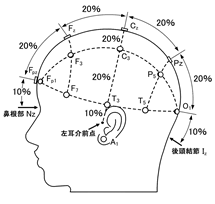BRain Analyzer is a tool for data pre-processing and statistical analysis. The analytical method is based on Block Averaging.
BRain Analyzer is a tool for data pre-processing and statistical analysis. The analytical method is based on Block Averaging.
In the latitudinal direction, the probe center can be aligned with the Fpz position, or the lines of the lower row probes can be aligned with the T3, Fpz, and T4 line positions. It depends on whether you want to focus on orbital measurements or cover the entire prefrontal cortex. The best way to determine which brain coordinates the probe position corresponds to is to measure the probe position in 3D and map it to a standard brain using NIRS-SPM, for example.
The position of the Fpz is ([Ref.])
The distance from the root of the nose (nasion: between the eyes at the base of the nose) through the top of the head (apex of the skull) to the occipital tubercle (inion: a ridge in the center of the back of the skull) is measured with a tape measure. It is more accurate to pass through the center point determined earlier. The midpoint (50%) of the line is the Cz. Fpz is 10% up from the root of the nose.
The location of T3 and T4 is,
“[2] Determination of the temporal reference position Measure the distance from the left preauricular point to the right preauricular point through Cz. 20% down to the left from Cz is C3, and another 20% down is T3. Similarly, C4 is 20% to the right of Cz, and T4 is 20% further to the right.”
Translated with www.DeepL.com/Translator (free version)
[Reference] Excerpt from page 46 of “Event Related Potentials Guidebook,” by Hiroshi Iritono, Kitaoji Shobo
To strictly measure the actual probe position, use a 3D probe position measurement system, for example, Patriot (Polhemus).
